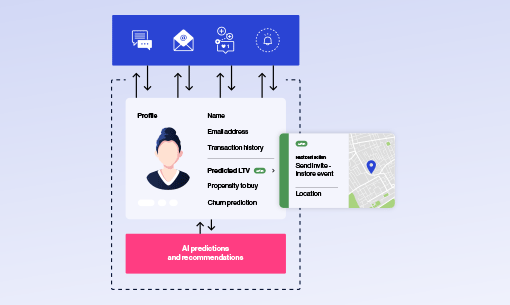Why is customer segmentation important?
By Catherine Frame on December 6, 2022 - 5 Minute ReadIf you’ve been keeping a close eye on some of our recent blog posts (and if not, don’t worry — they can all be found here!) you’ll have noticed the word ‘segmentation’ crop up a fair few times.
It’s safe to say that we’re big fans of customer segmentation here at Peak, for a number of reasons. Later in this article we’ll delve into these in more detail, but let’s first take a step back and ask some important questions…what is customer segmentation, why is it important and why do marketing teams need to harness its power?
What is customer segmentation?
Customer segmentation is the process of creating cohorts of customers into groups of similar commonalities such as demographics, product preferences and value to a company.
For many businesses, this is considered a basic principle of marketing, along with the likes of email automation and personalized targeting. The question we often get asked is that, by its nature, segmentation reduces the size of the pool of potential customers who can be targeted by you — so why would you do this?
Yes, segmentation does limit the number of customers you reach out to, however what it does do is increase relevance. By finding commonalities between your customers, you’re unearthing key connections, mutual interests or shared needs.
For example, let’s say we want to send a birthday campaign to our customers who have a birthday that falls in November. We’d create a segment of ‘Birthday Month = November’, and the campaign would then include some birthday-related content along the lines of: “It’s your birthday this month, {{Name}} — wishing you the best birthday yet!”
Now, imagine that same message being sent without customer segmentation. My birthday falls in September, so do I want to receive this message in November? Absolutely not! What does that do to me as a customer? It makes me highly disengaged with the brand and unlikely to engage with them going forward. It highlights that the brand doesn’t see me as an individual but instead as a mechanism to try and attain revenue.
What’s my likely next step? I unsubscribe from their communications, and no longer want to be contacted by them no matter how much I like their products or experiences; they’ve essentially switched me off as a customer.
Whilst this is a very high level, tongue in cheek example the principle remains the same when it’s applied to more complex scenarios. Let’s say I’m browsing on a website, add a pair of sneakers to my basket, but I’m too indecisive so end up closing the browser. Within thirty minutes, I get major FOMO and decide, “no, I actually really need those sneakers!” so I log back in to purchase.
The next day, I get an automated abandoned basket email: “Don’t forget to complete your purchase! Here’s an additional 10% off if you purchase today!” In this scenario, once again I’m left feeling disgruntled and irritated. Plus, all you’re doing is highlighting to a customer that if they wait to make their purchase, the likelihood is that they’ll receive a discount code. This gives the customer the ability to repurchase the item at a lower price — eroding margin unnecessarily and, additionally, causing an item return. All parties lose in this situation, so it really is important to segment, and segment correctly. So, how do you do this?

How to segment customers
You need to make sure that you find meaningful reasons to contact your customers. Step away from the ‘spray and pray’ approach to marketing communications and invest your time and efforts into creating and building relationships with your customers, not just transactions. Identify and predict what they want, when they want it.
An example of this is building a propensity to purchase artificial intelligence (AI)-driven model. You’re talking to customers who are predicted to be ready to make a purchase, so it’s on you to make sure you understand what they’re interested in and what their preferred channel is. Do this by employing an AI recommender in each communication and touchpoint, enabling you to provide personalized messages at scale and build a model to determine their channel preferences.
Identify your customers’ previous purchases and behaviors, and use these to map future communications. In the above example, where I purchase sneakers, a good example of segmentation could be a follow-up communication introducing sneaker protection spray: “keep them looking white for longer!”
The segments to create this would be as simple as “purchased sneakers yesterday + did not purchase sneaker protection spray.” This nice touch makes a customer feel fully recognized, and ultimately contributes to a better experience with your brand — and leads to additional sales!
Finally, consider using site metrics to gauge a customer’s interest. Customers who’ve visited your site within a specific time frame indicates potential for sales. For example, pulling a segment of “has visited the site in the last three months” shows a level of interest in what you’re offering — even if they haven’t purchased anything yet. Perhaps your next promotion could be the final push they need to convert?
What are the key customer segmentation metrics?
The traditional metrics that matter when it comes to customer segmentation — those that you’d consider when determining whether or not your segmentation strategy is working — would include basic engagement metrics such as opens, clicks and conversions.
However, truly personalized segmentation needs to take this one step further. One of the most critical metrics to look at is lifetime value (LTV). High LTV customers are those customers that are predicted to be worth the most to you throughout the course of their time with you. Typically, the happier the customer, the higher the LTV. Equally, measuring much bigger strategic key performance indicators (KPIs) such as net promoter score (NPS) will be crucial when gauging whether your customer segmentation is hitting the mark!
Want to learn more about customer segmentation?
Interested in customer segmentation and marketing? Join us for a webinar on headless segmentation, a new approach to marketing that we’re pioneering here at Peak. In this webinar I’ll be explaining how AI, when applied in the right way, is transforming marketing teams’ performance — enabling scale, automation and, ultimately, personalization for your customers like never before. Get involved and sign up via the link below!

Headless Segmentation: The only way to win with your customers
More from the author




